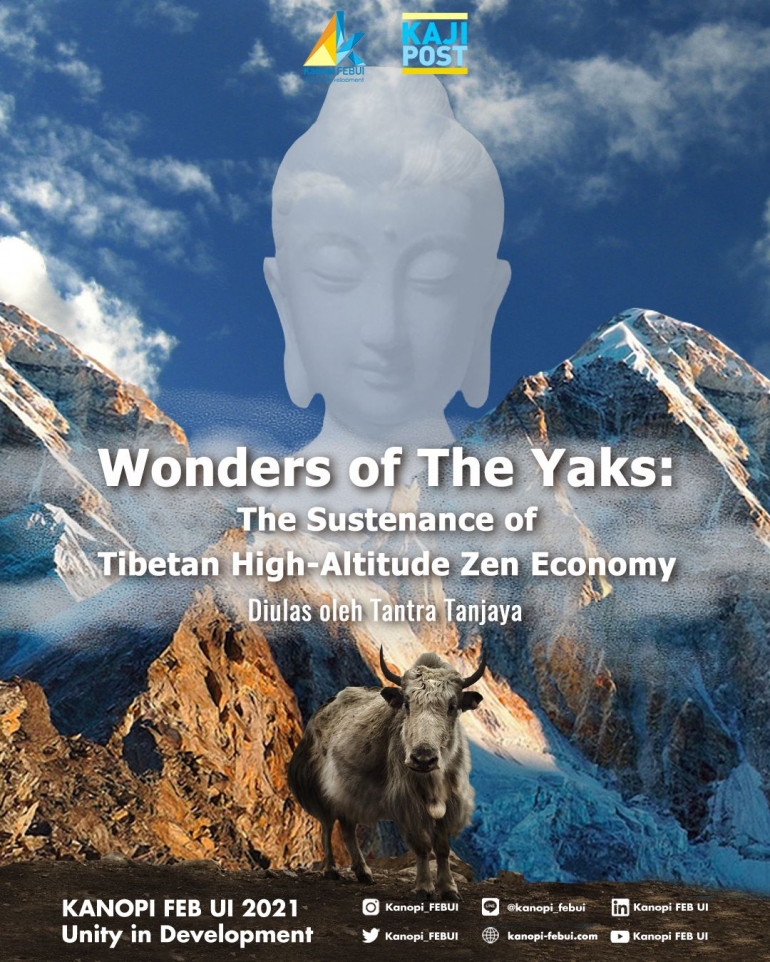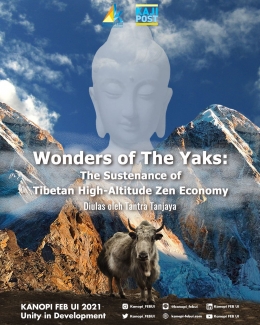Thousands of years ago, Tibetans believe Thpa Gali, their god of livestock, defiled a female yak in order to domesticate the entire species. Furthermore, they believe it was him who taught them how to raise and graze yaks and established the first nomadic way of life. Fast forward to today, and over 80% of Tibetans still work in the same sectors (Britannica, 2021).
Due to limited arable land and movement constraints from China's central government, agriculture, especially herding activity, still accounts for much of the Tibetan economy as we see it today. Furthermore, the Tibetan plateau was often called the "roof of the world", in which oxygen is limited and alternative economic activities are in short supply.
As Tibet undoubtedly is one of the world's harshest environments, it's hard to imagine how men managed to survive for thousands of years living on the plateau.
Crops are hard to grow, livestock are rare to encounter, while choice of economic activities are restricted to some basic, subsistence activities. Some might have wondered how Tibetan people survive under this economic structure. The answer is quite simple: yak. Ironically, never before an animal with such importance has so little recognition.

They are closely linked to the cultural and ritual activities of Tibet's herding societies. In particular, the yak underpins the economy of much of this region. The survival of Tibetan people under this economic structure is made possible due to this animal.
Almost all of the yak's body parts have uses, including for medicine, daily staples, clothing, and farming. Moreover, in Tibetan culture, the wealth of nomads is judged by the number of animals they own, especially yaks (Wu, 1997). However, prestige and social status are not the only reasons for keeping as many animals as possible.
Possession of a large number of animals provides extra insurance against the death of animals in times of severe cold or drought on the plateau. Not to mention, the yak ensures the endurance of the nomads' way of life in a region with an altitude as high as Tibet by providing them with navigation and alternative entertainment such as yak racing.
Paradoxically, the same animal that provides the Tibetans with their living apparently is constraining them from transitioning their economy into a more diverse structure. This is a phenomenon unique to the Tibetan economy as it isn't the case with the rest of the world. Common economic analyses have identified three large economic structures as the foundation of most countries:
Agriculture, manufacturing and services. Generally, the current economic structure we are facing forces us to adapt to changes in how the modern economy works. As a matter of fact, when the agricultural sector experienced rapid modernization in the 1920s, it created disruption in the form of millions of unemployed farmers. Eventually, this wasn't a big problem as they adapted and entered low-income industrial jobs.
Fast forward to the 1960s, the same adjustment also happened when the manufacturing sector started to experience automation. It resulted in millions of unemployed workers entering low-income service work. On the other hand, today, we face a new and bigger problem. As automation swiftly advances in most low-income service jobs, workers bear most of the consequences as their jobs would be eliminated. It will create swathes of workers that don't exactly fit in the incoming economic structure, nor do they have the skills necessary to seek other alternatives.
Such rapid automation leads to a new unemployment problem because the possibility for these low-skilled workers to move up to high-income jobs is zero to none. This unprecedented structure doesn't even provide other industries for these workers to enter. Therefore, with more people and entities recognizing the problem we face today, they present a counter-argument in which they advocate the deliberate and measured effort to decelerate the growth rate of the world's economy (Club of Rome, 1968).
They further argue that this approach, which was dubbed degrowth, would lead to a better society in terms of well-being, environmental quality, and strong community values. Degrowth emphasizes the need to reduce global consumption and production activity in the name of advocating a sustainable society, even if it comes at the cost of GDP growth.
By focusing on the environmental and sociological impact of development, this approach tries to argue that economic development can not be measured in absolute terms. They further strengthened the argument by citing the declining quality of environment and lower quality of life on Earth as a sign that economic growth doesn't reflect the standard of living. The concept of degrowth is also accompanied by other initiatives like Buddhist economics, anti-consumerism, and the 'downshifting' trend. Regardless of that, critics call the approach a flawed one. The argument fell short in addressing the limits of limiting growth rate itself.
Some might argue that there are still a lot of countries in need of a higher, not lower rate of economic growth to properly develop themselves. But, here's the catch - the Tibetan model provides a better insight into which policymakers might try to implement the concept of degrowth constructively. While most of the consumption activities in most economies are recorded in the calculations of Gross Domestic Product, the consumption process in the Tibetan economy is viewed as a part of the informal economy. It is partly due to the fact that most of their consumption-related activities are linked to their livestock, in the form of yaks. While the activity of cultivating the yak is not calculated as part of Tibet's GDP, it provides the daily staples and other needs for the daily survival of Tibetan people.
Moreover, the self-sustaining way of life displayed in the Tibetan model doesn't necessarily mean the people can't prosper. In fact, by living such lives, they become tourist attractions. Furthermore, their cultural values strengthened their status not just as a self-sustaining economy, but arguably as a successful example for the transition process into the high-value service industry. By implementing a dual strategy of using yaks for both daily sustenance and tourist attractions (such as yak racing and rituals), Tibetans developed a stronger and more cohesive community, all while their purchasing power increases year by year as part of the tourism initiative.
In conclusion, it's impossible for most countries to recreate the Tibetan degrowth model on a large scale. Yet, nonetheless, it is a way to reimagine an alternative to a purely market-based economy. Instead of focusing on growth and numbers alone, it appeals to the more humane side of people by preserving their culture and improving their economic condition by utilizing community-based solutions, even if that comes in the form of an animal called yak. Surely, Thpa Gali would have been proud to know the way of life he established still exists until today. Without any doubt, it is truly a peaceful Zen Economy.
References:
1. Wu, N. (1997). Ecological Situation of High-frigid Rangeland and Its Sustainability - A Case Study on the Constraints and Approaches in Pastoral Western Sichuan. Dietrich Reimer Verlag, Berlin.
2. Linziduojie, L. (1996). Environment and development of the Qinghai-Tibetan Plateau. Beijing, China Tibetology Publishing House.
3. Brittanica.com: Tibet
4. Karchung, Gengop, From Yak-Herding to Enlightenment The Legend of Thopa Gali: A Heritage Narrative of the Merak-Sakteng Community, 2013, Bhutan
5. Sen, Amartya (1999). Development as Freedom. Knopf.
6. Browne, Clair (2017). Buddhist Economics: An Enlightened Approach to the Dismal Science. New York: Bloomsbury Press
7. Schumacher, E. F. (1973). Small is Beautiful: Economics as if People Mattered. New York: Perennial Library
8. D'Alisa, Giacomo; et al., eds. (2015). Degrowth: A Vocabulary for a New Era, London: Routledge. ISBN 9781138000766.
Baca konten-konten menarik Kompasiana langsung dari smartphone kamu. Follow channel WhatsApp Kompasiana sekarang di sini: https://whatsapp.com/channel/0029VaYjYaL4Spk7WflFYJ2H









